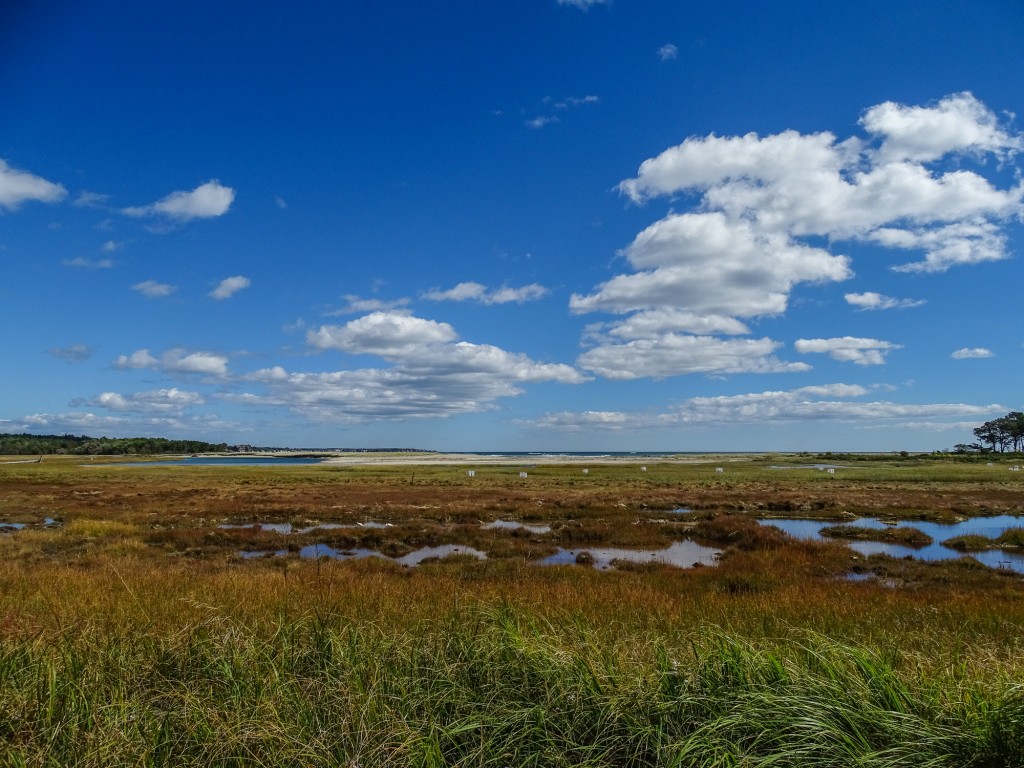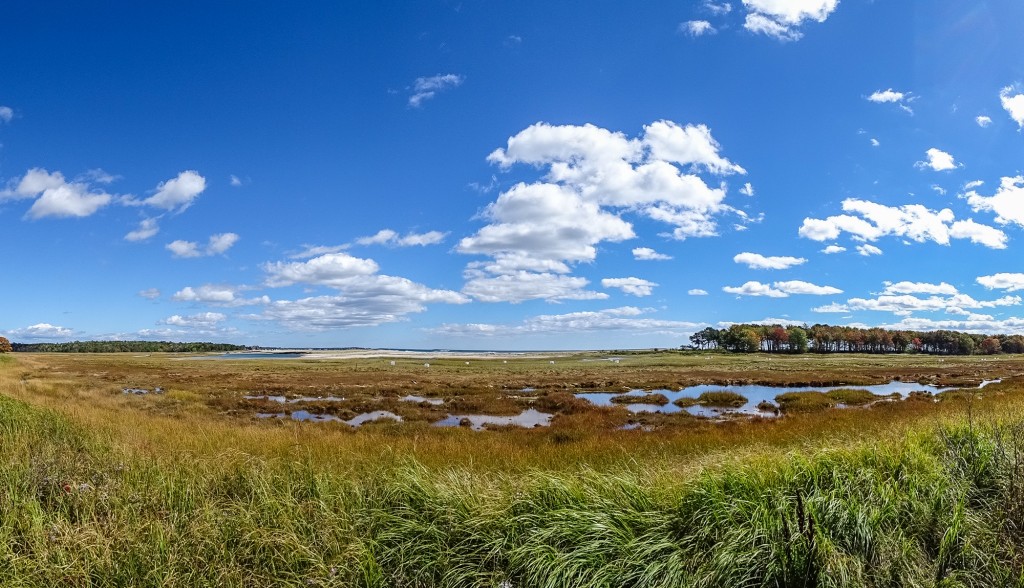
Sometimes, when faced with a grand landscape, wide-angle, no matter how wide the wide end of your zoom is, is simply not wide enough. Most of the recent P&S superzooms reach 24mm equivalent field of view…and a few reach 21mm. Both will embrace a generous expanse of land and sky, as you see in this conventional wide angle shot.

But is that enough? When faced with a landscape and sky like this one, I am always tempted to try a panorama shot.
There were, back in film days, specialized panorama cameras that featured rotating lenses that painted a panorama on a long strip of film on a curved film-plain. In the digital era, panoramas were created by taking several overlapping frames and stitching them together in software after the fact. The software started out as single purpose, stand-alone programs that you used before or after whatever photo editing program you used. The challenge was to match the edges of the frames perfectly and then blend the exposures at the edges to create a seamless image. Not easy, even with the help of a computer. Eventually the math behind the problem became well enough established so that main-steam photo editing software, even inexpensive software like Photoshop Elements, had a panorama function built in. They did a decent job, as long as your exposures were relatively consistent, and you did not use a lens with too much distortion at the edge of the field where the images had to blend. And, if the perspective of the three shots worked. Shooting from a tripod might keep the images aligned, but, ideally, rather than rotating about a fixed point, the camera should sweep through an arch so that the lens, essentially, rotates as it did in a dedicated panorama camera to embrace the scene. Specialized tripod heads were developed to accomplish that, but panoramas were still not easy to do. Which is why we saw so few.

I seem to remember that Sweep-panorama was first introduced in phone cameras. The tiny fast CMOS sensors in phones were able to essentially paint the image to a file one narrow band at a time as the phone was swept across the extent of the landscape, almost as though you were panning a video camera. Nice trick. And, since you were framing the image on the LCD of the phone, it was natural to hold the camera out from your face and sweep it in an arch by rotating your whole body. Ideal! Suddenly panoramas were a lot more common.
I believe it was Sony who first introduced sweep-panorama to the P&S world, along about the time the first fast back-illuminated CMOS sensors found their way into P&Ss. The other makers lagged somewhat…building in conventional multiple scene stitch together assist panorama assist…but with this last generation of P&S superzooms, I am pretty sure they all feature sweep-panorama.
Keys to success:
1) Meter off the area of the scene you want to be best exposed. Do no simply point at one edge and press the shutter. Pick the area of the scene with the average brightness, or the area, as above, that is most important to you, point at it, half press the shutter to lock exposure (that works on most cameras, some may have a separate exposure lock button), rotate back to one edge of the scene and fully press the shutter button to start exposure.
2) as above, hold the camera out in front of you several inches to a foot and sweep it across the scene in an arch, rotating your body if necessary. There should be a straight line from the horizon through the camera lens to the center of your body at all times. It is easier to do than it is to describe. 🙂
3) if your camera has guide-lines that can be turned on for framing the scene on the LCD, turn them on and use them to keep the horizon level and placed correctly as you sweep.
4) keep the speed of the sweep uniform. Your camera will generally alert you and the panorama will fail if you go too fast or too slow. A little practice makes perfect.
Tips:
Don’t limit yourself to long narrow horizontal panoramas. Most cameras will allow you to set the direction of the sweep. Try some horizontal sweep-panoramas with the camera held in portrait orientation (vertically). This will produce a pano that is wide, but also taller than normal, for some very interesting (and more natural looking) effects. Compare this to the long panorama of the same scene at the head of the post.

And don’t limit yourself to horizontal panoramas at all. A vertical sweep pano can capture the sky effects better than almost any other technique.
Finally, try shooting panos, especially vertical panos of things that are not, on first glance, pano subjects. Vertical panoramas of trees, for instance, can show the tree in a way you rarely see it presented…whether you are after the massive scale of forest giants, or the intimate detail of an interesting trunk.
So sweep away…but don’t get swept away. Panoramas are fun, but as you might have observed here, they are hard to display on any kind of screen or monitor. Still there are times when the landscape or the subject simply demands that you break the bounds of the conventional wide angle frame. And sweep-panorama in today’s P&S superzooms will do the trick. Give it a try.




Truly amazing pics. Is this with hx400? I zoomed in expecting to see noise and smearing but looks clear. Can you list your camera settings for these pics.
I have a6000 I don’t think I can do horizontal pano in portrait. Will have to check again. I didn’t think it was possible on the hx400. Panorama is not easy on a6000.
I read your review of the hx400. is the viewfinder better than sx50? I only shoot with viewfinder and sx 50 is poor . Both have 200k.
The panos are all with the HX400V. Pano mode uses Auto everything, but I adjust to -.7EV to protect the sky, and use Landscape Creative Style set to 0 Contrast, +1 Saturation, and -1 Sharpening. The a6000 has an electro/mechanical shutter…an actual shutter which moves across the sensor for exposure, while the HX400V has a purely electronic shutter…essentially a switch. Sweep pano is much easier and smoother with an electronic shutter camera. I don’t understand why Sony does not use the Video mode for Sweep panorama in the a series cameras ??? The ELV in the Sony HX400V is slightly brighter and slightly bigger than the one in the SX50, so the image looks better…it is not however much easier to use. 🙁
Auto everything, so no way to limit ISO to 80? What is the ISO and shutter speeds on these shots? Thanks
Tu turns out you can do portrait pano on the a6000, have to find direction in menu which admittedly is a pain. It does not seem to give you the full scene that is shot though and cannot display the image but must play it from left to right